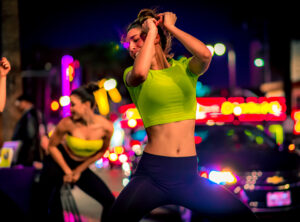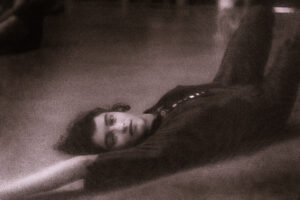Candy Hearts
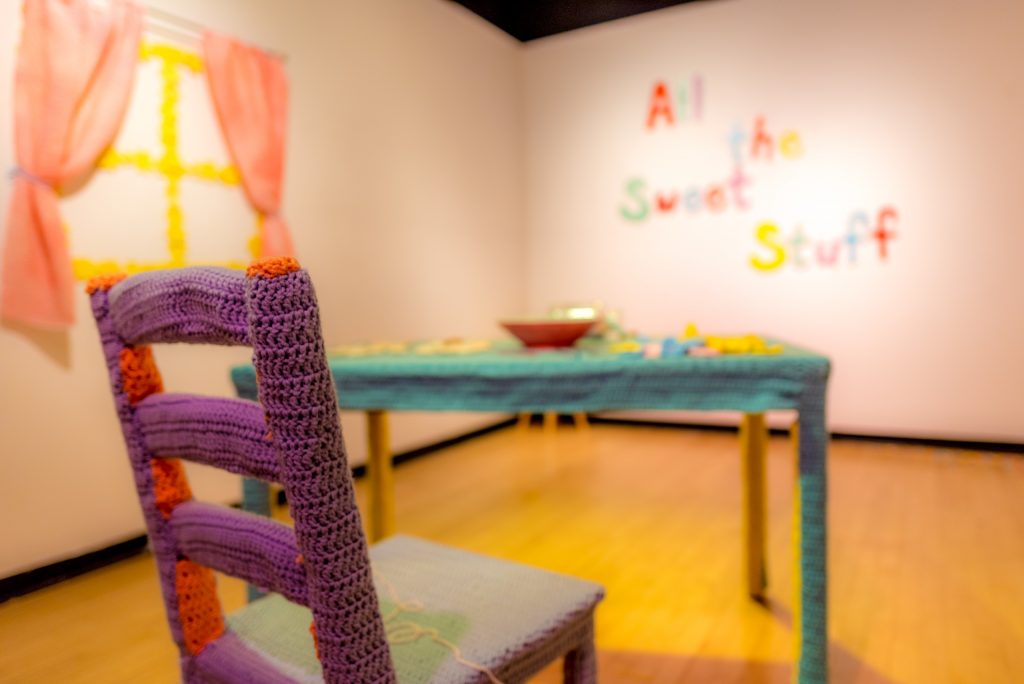
Table of Contents
ToggleExhibition Information
Artist: Claudia V. Solorzano
Exhibition: All the Sweet Stuff
Media: Ceramic & Fiber Installation
Gallery: Long Beach State University, School of Art, Merlino Gallery
Website: claudiavsolorzano.wixsite.com/artist
Instagram: @claudia.v.solorzano
LinkedIn:
click any image to see it full screen
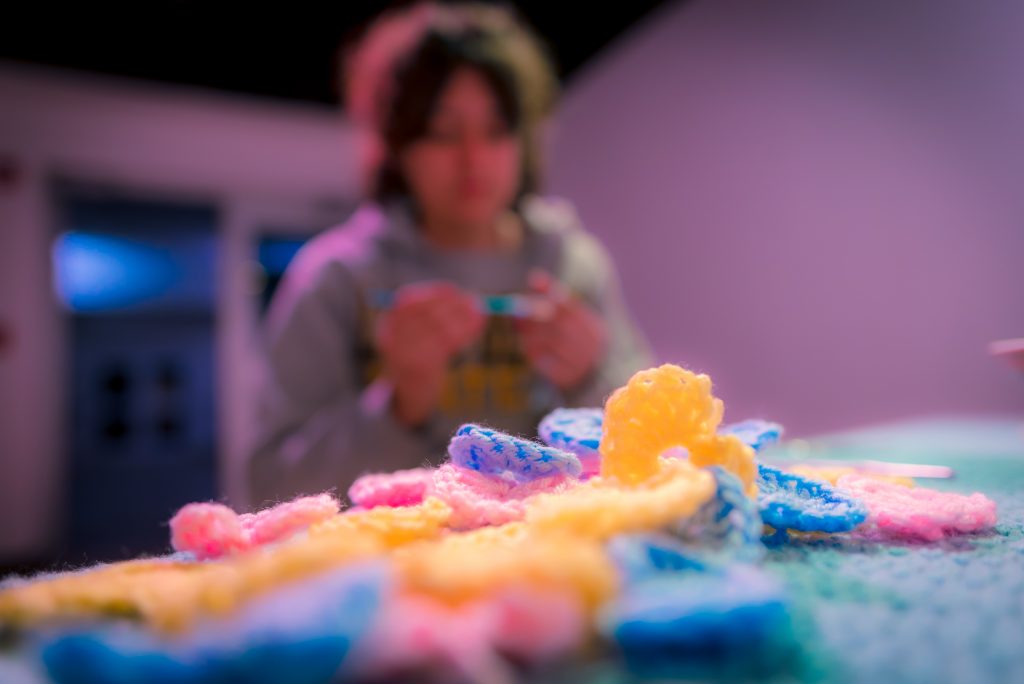
Love & Growling
As I approach Claudia Solorzano’s show at the Dr. Maxine Merlino Gallery in the courtyard at Long Beach State University’s School of Art I see a man and a woman sitting at a table outside the gallery. I eye them for a moment as I approached and then ask,
You must be the parents?
Yes, we are.
Congratulations!
I shake Michael Rangel’s hand, and as I do, the dog on his lap begins to growl at me. I withdraw my hand as the handshake finishes, but that doesn’t help. I’ve violated private space and Benjamin is not about to just let that go. Even though I’m backing away, Benjamin is growling more. I don’t even try to shake Celia Rangel’s hand.
I’m not too worried about this as my mom’s Chihuahua, Tiki, does the exact same thing. If someone tries to hug my mom while Tiki’s on her lap, they are in for a world of trouble!
Michael & Celia; Benjamin & Romy
As Michael Rangel takes Benjamin for a short walk to diffuse the situation I’ve inadvertently triggered, I realized how much love and protection artist Claudia V. Solorzano has outside her gallery door.
Solorzano is a part of her ceramic & fiber installation. During the hours of the exhibition she sits at a table at the center of the gallery with her back to the door. Here she crochets hearts in pink, blue, or yellow, and gives one to each visitor to the gallery.
Aren’t you vulnerable with your back to the door? I hear Mafia bosses sit with their backs to the wall and facing the door so that no one can sneak up behind them.
Yes, but then I might have to see someone I don’t want to see. I’m safer not looking out. And I have people who protect me.
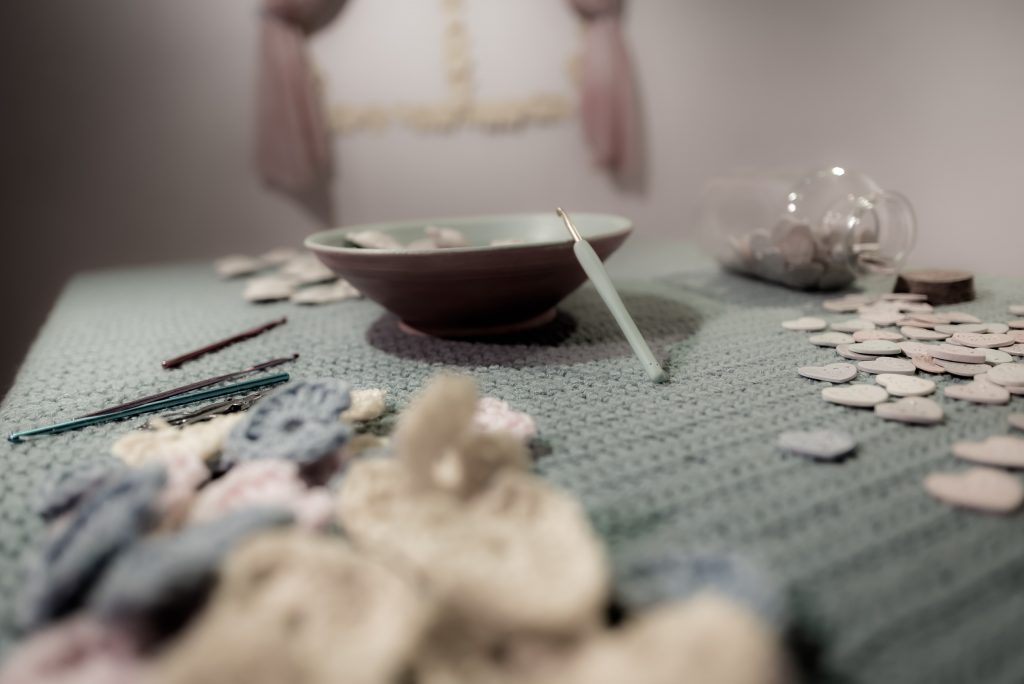
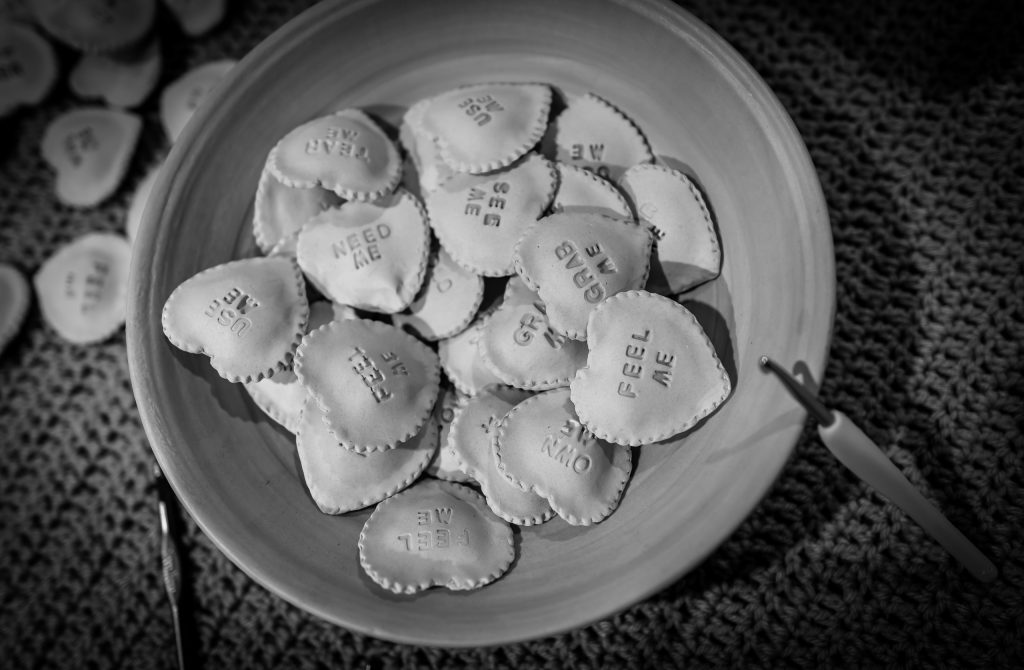
Insipid Fortune Cookies & Lit Candy Hearts
Unlike the insipid Fortune Cookie which contains neither a fortune nor much of a cookie, the Candy Heart is as edgy and incisive as it is sugar-filled and pop-silly. I don’t know if there’s a Candy Heart Style Manual or not, but I believe the form is two monosyllabic words that don’t rhyme per se, but do “punch together.” The Candy Hearts that will be raining down on us in another month, like Feel It or Show Me, can be silly and surface, or they can cut to the bone. Like great art, Candy Hearts offer easy pleasure for the casual observer, and can reveal layers of meaning for those willing to spend time with them.
Solorzano’s Candy Hearts follow the form of the good Candy Heart:
- Feel Me
- Grab Me
- See Me
- Own Me
- Use Me
- Need Me
- Tear Me
- Break Me
- Kiss Me
- Know Me
Solorzano’s Candy Hearts do follow the Candy Heart Style Manual, but you’ll also notice they reference Me a lot. Like a candy Candy Heart, Solorzano’s ceramic Candy Hearts’ referent is slippery. “Me” could refer to the person reading the heart, the projected party speaking, or perhaps the Candy Heart itself. The referent could be anyone. But it feels like it is about Solorzano’s own journey and life experiences.
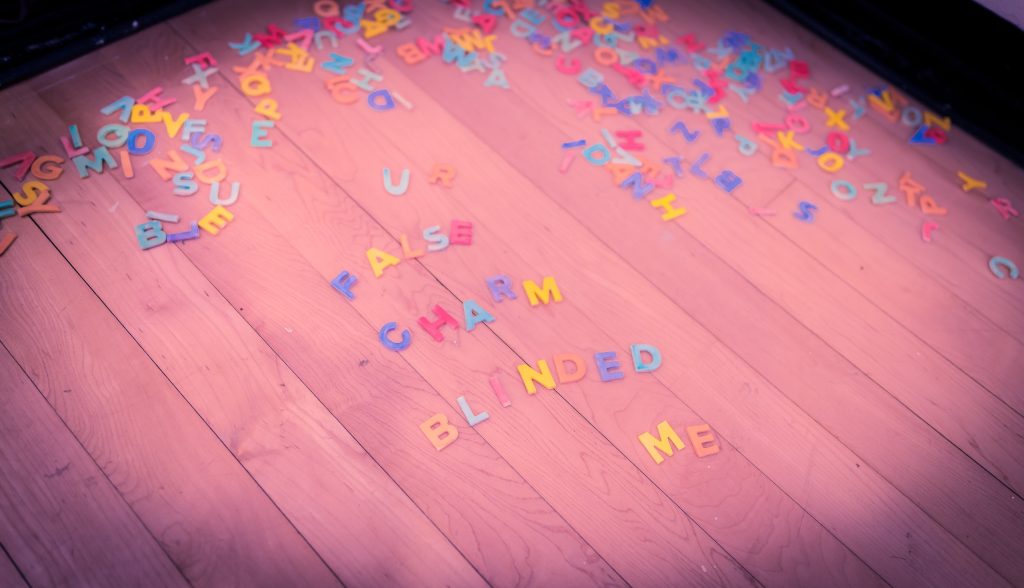
Claudia Solorzano, Marcel Duchamp, and Ravioli
Solorzano spent last summer in Italy. When she came home she started making Ceramic Ravioli Candy Hearts. Solorzano’s hearts are unglazed porcelain. Except for the letters, which use a mid-range glaze.
When you enter the gallery Solorzano tells you to feel free to touch the materials. The unglazed porcelain ravioli Candy Hearts have a porosity that feels bottomless to the touch. The edges are crimped like ravioli, and like a mysterious Duchamp box, something inside makes them rattle when you shake them.
Solorzano tells me that some visitors come through the gallery and say,
Candy Hearts, how cute.
They are sweet. Kiss Me is part of Solorzano’s narrative, but it is also a real Candy Heart. As simple and sweet or as open and suggestive as you like.
Other hearts, like Rape Me, are much more aggressive. Yet even that brutal heart seems to wink with mock innocence from behind its Candy Heart costume.

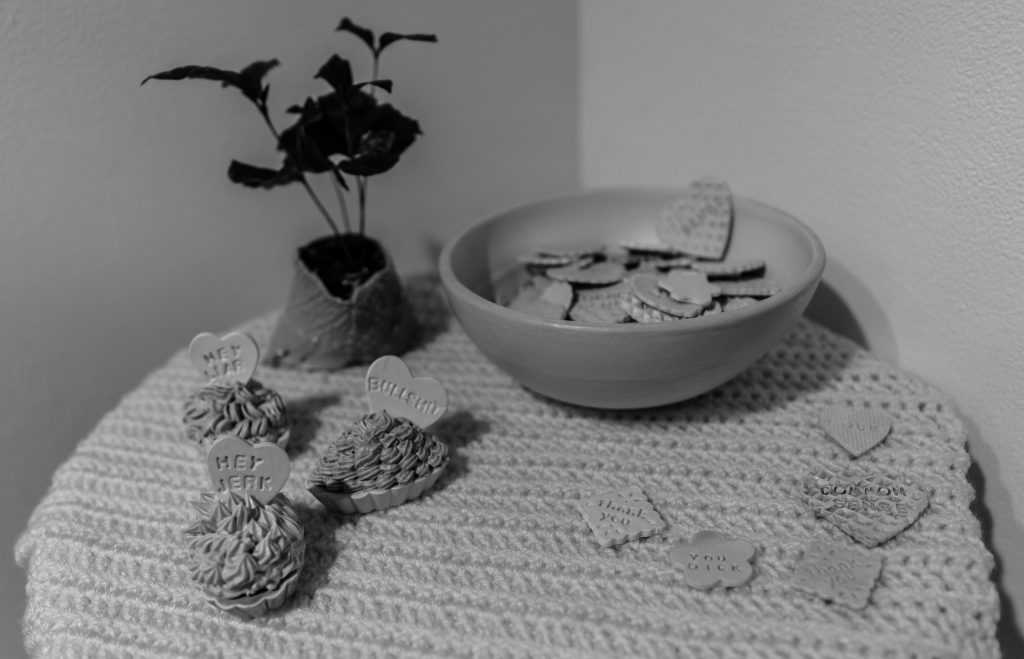

Break Me
Break Me is a song lyric. As soon as I touched that heart I heard a voice soulfully singing those two words in the back of my head. Music is different. You can sometimes tell an intense story, but if it’s got a beat, it can become more about the dancing than the depth of the story. Van Halen’s 1984 song Jump is one of the great dance party songs. It is also about someone standing on the edge of a building and considering ending their life. Most people jumping on the dance floor don’t think about that.
But incarnate as a porcelain-ravioli-candy-heart with black hole-like porosity, it is hard not to hold the heart in your hand and think about the pain we humans sometimes inflict on each other. By inviting gallery visitors to touch the objects, Solorzano is literally inviting us to hold her heart in our hands. Do we have a responsibility to treat the artist, or others, better than whoever motivated this work treated Solorzano?
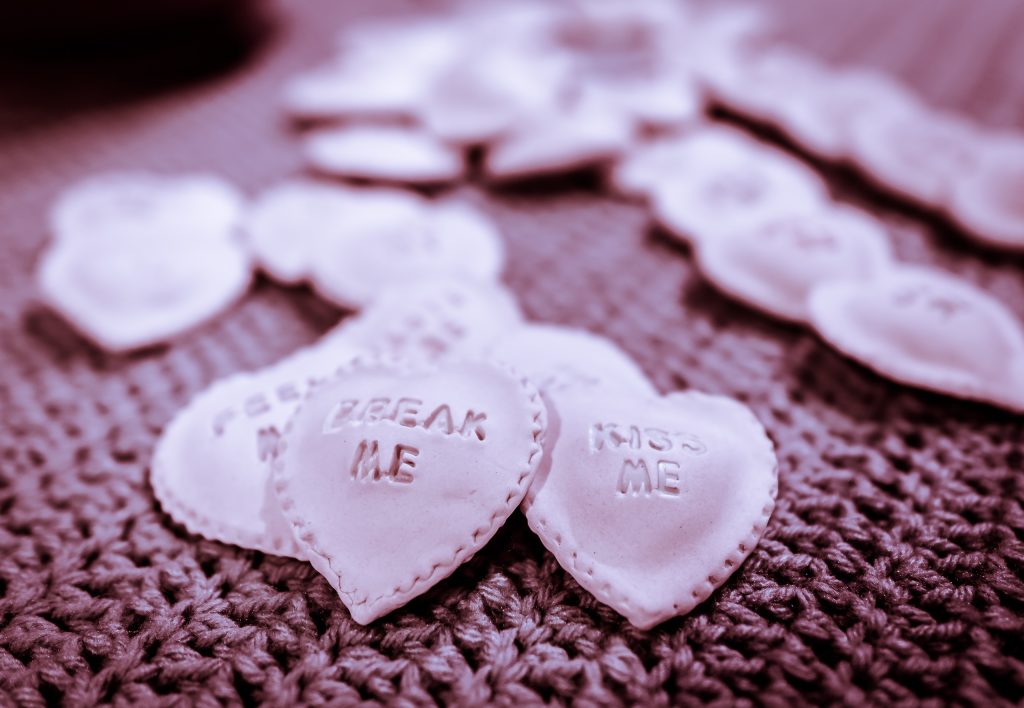
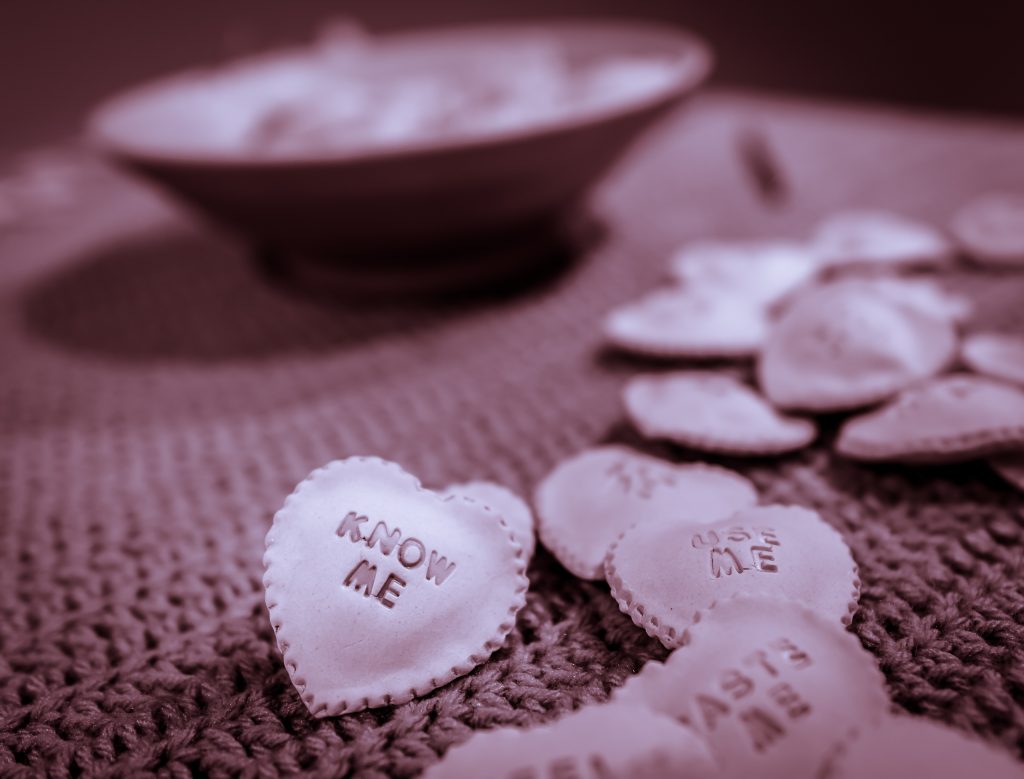
Know Me
There is an innocence lost to Claudia V. Solorzano’s installation All the Sweet Stuff. The strength of the installation suggests a strength that will survive. But is it broken? Can innocence lost be regained? Is this installation a requiem for a naïve innocence that can never return? Is it a quest to accept how hard the world can be, and to approach it with softness anyway, knowing that you might be broken once more?
Know Me. At it’s most basic, isn’t this what we strive for? It is why we write poems, why we make art, why we dance, why we sing songs, why we smile at strangers, why we do everything. It is the hope that in some small way, you can Know Me. If I have been broken, can I be vulnerable enough to be known?
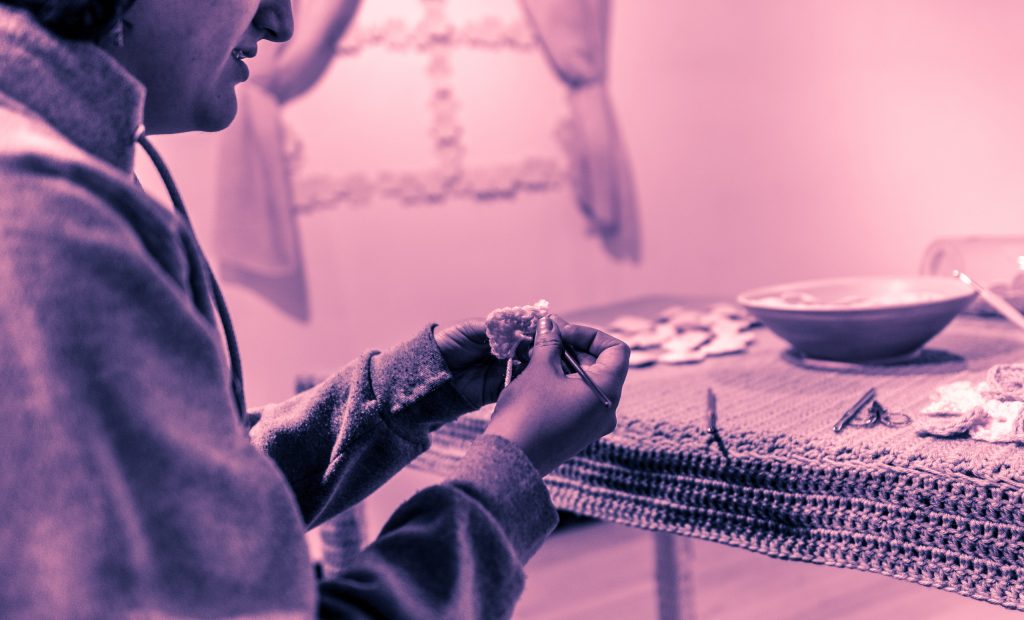
Women’s Work
Solorzano’s mother, Celia Rangel, tried to teach her crochet at age six, but it didn’t take. 7 or 8 years later she tried again, and this time it did. Solorzano and Rangel both seem pleased that there is so much of Solorzano’s crocheting in All the Sweet Stuff. It forms a fiber bond. It is the union of craft. It is the kinship of Women’s Work.
Obviously, not all women crochet. And obviously, some men do. Still, as I sat in the Merlino Gallery and watched Solorzano endlessly crocheting hearts at her table, it felt so very much like Women’s Work. It brought to mind a very different kind of Women’s Work, washing.
In the year 33 Mary of Bethany wept. Her tears fell on Christ’s feet. And she washed his feet with perfume and dried them with her hair. 1,944 years later Mierle Laderman Ukeles washed the steps of the Wadsworth Atheneum, an art museum in Hartford, Connecticut. And another 44 years after that, I watched a woman on her knees cleaning the sidewalk. Washing the 45th president-of-the-United-States’ Star on Hollywood Boulevard.
The woman wanted to take a “Thumbs Up selfie” with the star, and seeing that it was dirty, she got on her hands and knees and washed it. Men wash things too, but it is Women’s Work.
Solorzano crocheting tiny hearts, or the unknown woman in denim overalls washing a sidewalk star, is simple, humble work. It is not the heroicism of Richard Serra flinging molten lead against a wall. On the most superficial boulevard in all of America, this Women’s Work is deeply moving. The woman in denim overalls did not change my feelings toward the 45th president, but she did change my feelings toward his voters.

It’s Different for Girls
Solorzano began this work half a year ago when she returned from Italy. Many months before the Harvey Weinstein scandal and all that has followed it. Even though All the Sweet Stuff predates October’s invocation of #metoo, it is hard to look at All the Sweet Stuff and not consider the installation vis-a-vis our post-Harvey Weinstein moment.
Pick up each heart. Consider the text: the longing of Hold Me or See Me, the stinging patriarchal imperative of Own Me or Rape Me, the indeterminacy of Grab Me or Taste Me. So many of the hearts carry, in part, desirable qualities. So many of the hearts carry, in part, aspects of patriarchal culture, aspects of the military industrial complex, aspects of the slaughtering of animals.
What was Harvey Weinstein, and every now-toppled powerful man since him, doing? Was it about love? Was it about sex? Was it about the slaughtering of animals?
Donald Trump: I’m automatically attracted to beautiful — I just start kissing them. It’s like a magnet. Just kiss. I don’t even wait. And when you’re a star, they let you do it. You can do anything.
Billy Bush: Whatever you want.
Donald Trump: Grab ’em by the pussy. You can do anything.
— September 2005
And what of touch? The experience of touch is among the most important ways we connect with humankind. Can you still touch and be touched if you are broken? Can you Know Me if you can’t touch me? Can we still touch each other in a post-Harvey Weinstein world?
#metoo
The #metoo movement seeks cultural change. Solorzano’s installation seems more about one person’s cathartic journey. About discovering who you are. About what remains, about what is possible, after you’ve given them All the Sweet Stuff.
There is so much loss in this installation.
Yet with every heart Claudia Solorzano crochets, with every heart she gives to a visitor, connections are forged, community is created, love is shared.
Solorzano’s many texts (hearts) in the Merlino Gallery suggest that before we ever got to this gallery, there was once love, which became loss. Now in the gallery, loss becomes love.
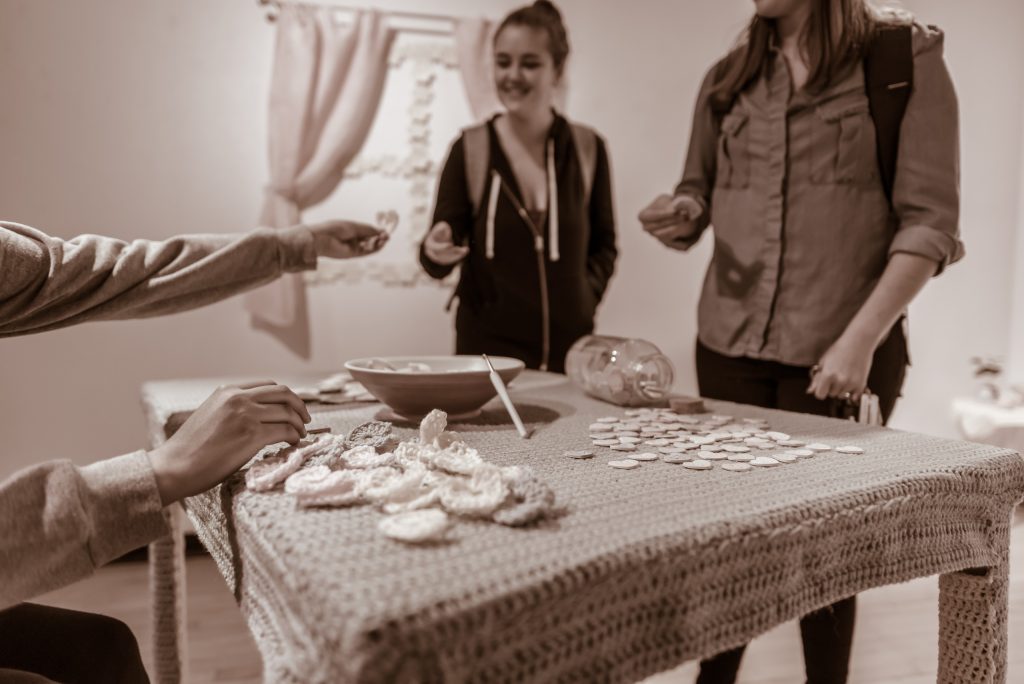
More Stories
Teddy Sandoval and the Butch Gardens School of Art
On Saturday the Vincent Price Art Museum held a closing program and celebration for the exhibition “Teddy Sandoval and the Butch Gardens School of Art.”
Krista Paulsen, “Posts + Beams”
Krista Paulsen’s Posts + Beams is all about attention to small details. And Paulsen is paying attention. With loving delicacy, she presents her observations of the architectural details of 8 buildings on the Long Beach State University campus.
Cintia Alejandra Segovia, “Gato Encerrado”
Are you an immigrant? Do you need help assimilating into your new culture? Cintia Segovia’s videos offer helpful instruction and practical tips that will make any immigrant’s transition to life in the United States easier.
Cortnee Brush, “Onanist”
In Onanist, Cortnee Brush confronts doubt about art, and doubt about her own art practice, with a performance work exploring her interior experience.
Mahsa Soroudi: Nature’s Cadence
conversation with Iranian artist Mahsa Soroudi. Life in Tehran. Immigrating to the United States and Southern California. We focus on two of her art projects, “Nature’s Cadence,” and “7,500 Miles.”
